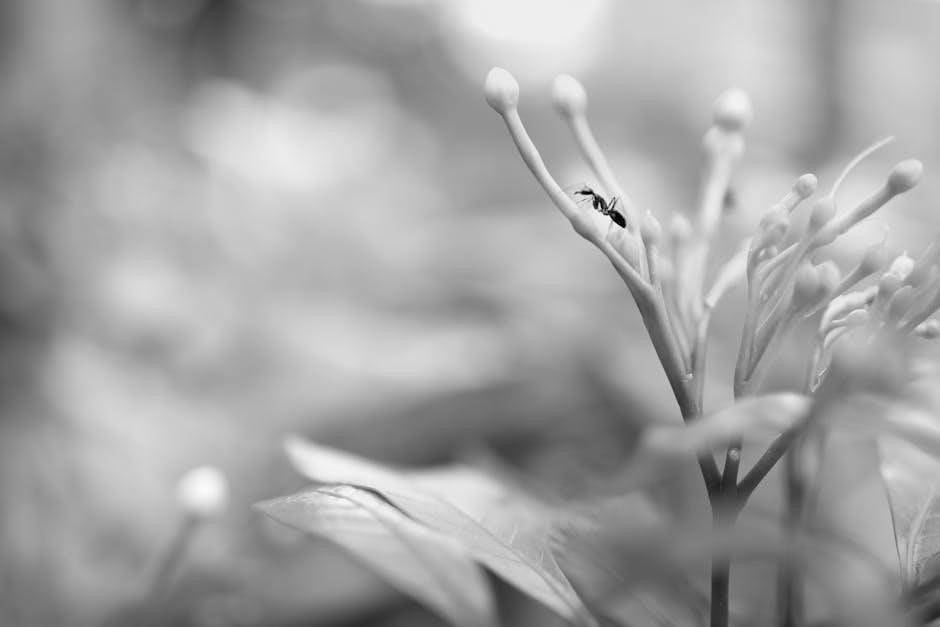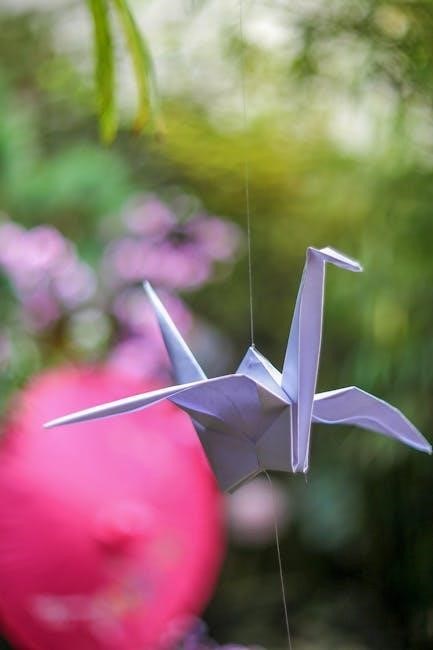origami flower instructions pdf
Discover the art of creating beautiful origami flowers with this comprehensive PDF guide. Featuring step-by-step instructions for classic models like the iris, lotus, and tulip. Perfect for beginners and experienced crafters alike.

Overview of Origami Flower Designs
Origami flower designs offer a wide range of artistic expressions, from simple to intricate patterns. Popular models include the classic iris, lotus, and tulip, each requiring unique folding techniques. These designs vary in complexity, catering to both beginners and advanced crafters. The PDF guides provide detailed step-by-step instructions, ensuring clarity for learners. Many designs emphasize symmetry and precision, while others allow for creative experimentation. Whether crafting a single bloom or a bouquet, origami flowers inspire patience and beauty. The guides often include diagrams and templates, making it easier to master each fold. This art form transcends mere crafting, offering a meditative experience and a way to create lasting, elegant decorations.
Importance of Using PDF Guides for Origami Flowers
PDF guides are an excellent resource for mastering origami flower techniques. They provide clear diagrams and step-by-step instructions, making complex folds easier to understand. These guides are convenient, offering a comprehensive learning experience in one place. Many PDFs include video links for additional support, ensuring learners can follow along seamlessly. The ability to download and print PDFs makes them accessible offline, perfect for crafting anywhere. They also allow for easy sharing and reference, making them ideal for workshops or personal use. Whether you’re a beginner or an expert, PDF guides streamline the learning process, ensuring precise and beautiful results every time.
Benefits of Learning Origami Flower Techniques
Learning origami flower techniques offers numerous benefits, including improved hand-eye coordination and fine motor skills. This traditional art form fosters patience and concentration, providing a meditative experience. Creating intricate designs can boost creativity and problem-solving abilities. Origami flowers are versatile, perfect for gifts, decor, or art projects. They also promote recycling by using repurposed materials. The sense of accomplishment from crafting something beautiful enhances self-esteem. Whether for personal enjoyment or sharing, mastering origami flowers adds a unique skill to your repertoire, blending tradition with modern creativity in a fulfilling and rewarding hobby.

Materials Needed for Origami Flowers
Origami flowers require square paper, preferably origami paper, which comes in various colors and patterns. You can also use recycled materials like magazine cutouts or gift wrap. Tools such as a ruler or bone folder can help create sharp folds. For added detail, glue or a pen can be used to enhance the final design. Optional items include scissors for trimming edges or stems made from paper rolls for a more realistic look. Ensure all materials are square-shaped for the best folding results. This setup provides everything needed to craft stunning origami flowers with precision and care.
Choosing the Right Paper for Origami Flowers
Selecting the right paper is crucial for creating beautiful origami flowers. Use square paper, as it ensures symmetry and ease of folding. Origami paper is ideal due to its thin, smooth texture and vibrant colors. For beginners, start with a 6×6 inch sheet, as it’s easy to handle. Larger sheets, like 10×10 inches, are perfect for intricate designs. Consider patterned or colored paper to add visual appeal. Recycled materials, such as magazine cutouts or gift wrap, can also be used for an eco-friendly approach. Ensure the paper is square-shaped to achieve precise folds and stunning results.
Tools Required for Folding Origami Flowers
While origami primarily uses paper, having the right tools can enhance your folding experience. A bone folder or similar blunt tool helps create sharp creases, essential for precise folds. A ruler or straightedge can assist in measuring and aligning paper edges. For intricate designs, scissors may be needed to cut paper into specific shapes. Optional tools include a cutting mat for precise cuts and a work surface like a table or board. Many guides also include video tutorials and PDF diagrams to guide you through folds. Ensure your tools are clean and dry to avoid damaging the paper during the process.
Recycling Materials for Eco-Friendly Origami
Transform recycled materials into stunning origami flowers while promoting sustainability. Use old magazines, colorful catalogues, or leftover gift wrap, cutting them into squares for folding. This eco-friendly approach reduces waste and adds a personal touch to your creations. Simply trim the paper to the desired size and follow the step-by-step PDF guides. Tools like scissors and a ruler can help prepare the material. This method not only supports environmental conservation but also infuses creativity into your origami projects. By repurposing everyday items, you can craft beautiful flowers while making a positive impact on the planet.

Basic Folding Techniques for Origami Flowers
Master foundational folds like the square base, rabbit ear, and Kusudama base. These essential techniques form the starting point for creating intricate origami flower designs, detailed in PDF guides.
Understanding the Square Base Fold
The square base fold is a fundamental technique in origami, often used as the starting point for various flower designs. Begin by folding your paper in half diagonally to create a triangle, then unfold and repeat in the other direction. This creates a crease that helps form the base shape. Next, fold the sides inward, aligning the edges to the center crease, resulting in a square base. This structure is essential for creating petals and achieving symmetry in origami flowers. PDF guides provide clear diagrams and step-by-step instructions to master this fold, ensuring a solid foundation for more complex designs.

Mastering the Rabbit Ear Fold
The rabbit ear fold is a versatile origami technique used to create small, triangular flaps that resemble ears. Begin by folding the paper in half diagonally, then unfold. Next, fold the sides inward, creating small triangles that meet at the center. This fold is essential for forming petals and intricate details in origami flowers. Ensure sharp creases for precision. PDF guides often include visual aids to help perfect this fold. Practice consistently to achieve symmetry and smooth transitions between folds. This technique is fundamental for advanced designs like the iris and tulip, making it a cornerstone of origami flower crafting. Patience and precision are key to mastering it.
Creating the Kusudama Flower Base
The Kusudama flower base is a foundational unit in origami, used to construct intricate floral designs. Begin with a square sheet of paper, folding it into a smaller square by bringing the top right corner to the bottom left corner. Crease firmly, then unfold. Fold the top edges down to meet the center crease, creating a diamond shape. Repeat on the reverse side to form a symmetrical base. This structure is essential for assembling multiple units into a 3D flower. PDF guides often provide detailed diagrams to ensure accuracy. Mastering this base is crucial for Kusudama designs, allowing you to create stunning floral arrangements with precision and ease.

Step-by-Step Instructions for Popular Origami Flowers

Learn to craft stunning origami flowers with clear, step-by-step guides. From classic designs like the iris and water lily to intricate lotus and tulip models, these PDF instructions offer detailed folding techniques and diagrams for precise results. Perfect for all skill levels, these guides ensure your creations bloom beautifully. Discover the simplicity and artistry behind each fold with comprehensive tutorials tailored to help you master every petal and detail. Whether you’re a beginner or an experienced folder, these instructions will guide you to perfection. Create your own floral masterpieces with ease and precision, bringing joy to every fold.
How to Make a Classic Origami Iris
Creating a classic origami iris is a delightful project that combines precision and artistry. Begin by folding a square paper into a smaller square base, ensuring crisp creases. Next, form the petals by folding triangular sections upward and outward, creating a layered effect; The iris typically requires 14 steps, starting with the square base and progressing to intricate petal details. Use clear diagrams from a PDF guide to follow each fold accurately. Once completed, add finishing touches like curling the petals for a natural look. This design is perfect for beginners, with step-by-step instructions and visual aids to guide you to a beautiful, lifelike iris. The use of colored paper can enhance the flower’s realism, making it a stunning decorative piece or gift. With patience and practice, you’ll master this timeless origami classic.
Step-by-Step Guide to Folding a Water Lily
Folding an origami water lily is a rewarding craft project that requires attention to detail. Start with a square sheet of paper and fold it in half diagonally to create a triangular base. Open the paper and fold the corners to the center, forming a smaller square. Next, fold the edges to create the lily’s petals, ensuring symmetry. The water lily typically involves 10 steps, with each fold building on the previous one. Use a PDF guide for clear diagrams and instructions. Once complete, gently shape the petals to give the lily a natural, blooming appearance. This design is ideal for those familiar with basic origami techniques, offering a serene and elegant result perfect for decorative arrangements or gifts.
Creating a Lotus Flower with Detailed Instructions

Constructing an origami lotus flower is a beautiful and intricate process. Begin with a square paper sheet, folding it diagonally to form a triangle. Unfold and repeat on the other diagonal. Fold the corners to the center, creating layered triangles. Next, fold the edges to form the lotus base. Use a PDF guide for precise diagrams. The key is achieving symmetry through each fold. The lotus typically requires 14 steps, with each fold enhancing the flower’s shape. Gently pull the petals outward to create a natural bloom. This design is perfect for experienced folders, offering a stunning and symbolic piece for meditation or decoration. The larger the paper, the easier to shape the delicate layers. Achieve a serene and elegant result with patience and attention to detail.

Advanced Origami Flower Designs
Explore intricate origami flower designs, including the Gloriosa Flower Ball and Narcissus. These complex models require precision and advanced folding techniques, offering stunning results for experienced crafters.
Designing a 14-Step Origami Tulip
Master the art of creating a 14-step origami tulip with detailed instructions. Begin with a square base, then fold petals meticulously. Each step ensures symmetry and realism. Use larger paper for clarity. Includes tips for stem attachment and leaf addition. Perfect for experienced folders seeking a challenge. PDF guides offer clear diagrams and video links for better understanding. Achieve a lifelike tulip with precision folding. Ideal for crafting gifts or home decor. This design showcases intricate layering and texture, making it a standout piece in any origami collection.
Constructing a Gloriosa Flower Ball
Learn to craft the intricate Gloriosa Flower Ball with this detailed guide. The process involves creating multiple flower units, each requiring precise folds. Start with the base unit, then assemble the ball by attaching each flower. The PDF instructions provide clear diagrams and step-by-step directions. Tips on choosing the right paper and tools ensure success. This advanced design is perfect for experienced origami enthusiasts. The end result is a stunning, three-dimensional floral sphere ideal for decorative displays or gifts. Practice patience and precision to achieve this beautiful, intricate origami masterpiece.
Origami Narcissus: A Masterclass Design
The Origami Narcissus is a sophisticated design created by master artists like Joost Langeveld and Marcio Noguchi. This intricate flower requires advanced folding techniques and precision. The PDF guide offers detailed diagrams and step-by-step instructions, making it accessible for skilled origami enthusiasts. The design captures the delicate beauty of the narcissus, with layered petals and a central trumpet shape. Achieving symmetry and realism demands patience and practice. Perfect for those seeking a challenge, the narcissus is a stunning addition to any origami collection. The guide ensures even complex folds are manageable, resulting in a lifelike flower with exceptional detail and elegance.
Using PDF Resources for Origami Flowers
Origami flower PDFs offer comprehensive guides with step-by-step instructions and clear diagrams. Downloadable templates and tutorials make learning easy. Perfect for all skill levels, from beginners to experts.
Downloading Free Origami Flower Templates
Access a variety of free origami flower templates online, perfect for crafting beautiful designs. Websites like Etsy and official origami forums offer downloadable PDFs with detailed patterns. From simple iris and lotus flowers to intricate tulip designs, these templates cater to all skill levels. Many include step-by-step guides and diagrams, ensuring easy assembly. Printable templates are ideal for DIY projects, allowing you to customize colors and sizes. Some resources also provide video tutorials for better understanding. Eco-friendly options encourage using recycled paper, making origami sustainable. Whether for gifts, decor, or personal enjoyment, these templates offer endless creative possibilities for origami enthusiasts worldwide.
Printable PDF Guides for Beginners
Beginners can easily start their origami journey with printable PDF guides designed for simplicity. These guides feature clear step-by-step instructions and diagrams, making it easy to follow along. Available on platforms like Etsy and specialized origami websites, they often include templates for popular flowers such as iris and lotus. The guides are perfect for those new to origami, as they break down complex folds into manageable steps. Many PDFs are free or low-cost, offering great value. They also provide tips on choosing the right paper and avoiding common mistakes. Printable guides are an excellent resource for learning at home, ensuring a smooth and enjoyable experience for newcomers to origami flower crafting.
Video Tutorials and PDF Combinations for Better Learning
Combining video tutorials with PDF guides offers an immersive learning experience for origami enthusiasts. Videos provide real-time demonstrations of intricate folds, such as the rabbit ear and square base, while PDFs offer detailed step-by-step instructions and diagrams. Platforms like Etsy and specialized origami websites often bundle these resources, ensuring learners can follow along at their own pace. For example, LaFosse & Alexander’s Origami Flowers includes both video and PDF files, making it easier to master designs like the gloriosa flower ball and narcissus. This combination is ideal for visual and hands-on learners, enhancing understanding and improving folding accuracy significantly.

Tips for Making Perfect Origami Flowers
Common Mistakes to Avoid in Origami Folding
Avoid improper alignment and uneven folds, as they disrupt symmetry. Ensure accurate creases and use the correct paper size for the design. Patience and precision are key to mastering origami flowers.
When creating origami flowers, avoiding common mistakes is crucial for achieving perfect results. One of the most frequent errors is improper alignment of the paper, leading to uneven folds. Ensure the paper is squared and creases are sharp. Another mistake is rushing through steps, which can cause misshapen petals or asymmetry. Using the wrong size or type of paper can also affect the outcome. To avoid these issues, always measure the paper accurately and follow the instructions carefully. Patience is key—take time to make precise folds and check each step before moving forward. Practice and attention to detail will help you master origami flowers effortlessly.
How to Achieve Symmetry in Origami Flowers
Achieving symmetry is essential for creating visually stunning origami flowers. Start by ensuring your paper is perfectly squared and creases are sharp. Fold each petal meticulously, mirroring the previous one to maintain balance. Use a ruler to measure and align edges for uniformity. Symmetry can be further enhanced by folding both sides of the paper simultaneously. Pay attention to the angle and depth of each fold to ensure consistency. Regularly check your progress to correct any discrepancies early. With patience and precision, your origami flowers will bloom with perfect harmony and beauty, making them ideal for decorations or gifts.
Adding Details to Enhance Your Origami Creations
Elevate your origami flowers by incorporating intricate details. Use a toothpick or fine tool to create texture on petals, mimicking real flower veins. Add centers with small beads or paper dots for a realistic touch. Experiment with layering techniques to add depth and dimension. For a natural look, gently curl petals using a pencil or stylus. Consider adding a stem made from wire or paper to complete the flower. These finishing touches transform simple folds into lifelike blooms, making your creations stand out. Enhance your origami art with patience and creativity for truly exceptional results.
Cultural and Creative Uses of Origami Flowers
Origami flowers are perfect for home decor, gifts, and special occasions. Use them in art projects, as symbols of beauty, or to celebrate cultural traditions. Create lasting impressions with these delicate, handcrafted blooms.
Origami Flowers in Decor and Gift Ideas
Origami flowers add a delicate touch to home decor and make thoughtful gifts. Use them to create stunning DIY flower walls for events or as elegant centerpieces. Their intricate designs can brighten up rooms or serve as unique gift decorations. For special occasions like weddings or baby showers, origami flowers can be crafted into beautiful backdrops or bouquets. They also make charming additions to hair accessories or card embellishments. With their timeless appeal, origami flowers offer a creative way to personalize gifts and enhance spaces, making them a versatile choice for both practical and artistic purposes.
Using Origami Flowers for Special Occasions
Origami flowers are a perfect addition to special occasions, offering a delicate and artistic touch. They can be used to create stunning wedding decorations, anniversary gifts, or baby shower accents. Craft beautiful origami bouquets or use individual flowers to embellish cards and presents. For events, origami flowers can decorate tables, arches, or backdrops, adding a personal and creative element. They also make thoughtful gift toppers or party favors. With their versatility, origami flowers bring elegance and charm to any celebration, making them a popular choice for marking life’s memorable moments in a unique and heartfelt way.
Incorporating Origami Flowers into Art Projects
Origami flowers are a versatile medium for enhancing art projects, offering a unique blend of precision and creativity. They can be integrated into mixed-media collages, 3D sculptures, or wall art, adding intricate details and texture. Artists often use origami flowers to create thematic installations, such as garden scenes or floral motifs, bringing elegance and dimension to their work. Additionally, origami flowers can be combined with other materials like fabric, paint, or paper to craft hybrid art pieces. Their delicate beauty makes them a popular choice for exhibitions, while their portability allows them to be used in wearable art or interactive displays.
For educators, origami flowers are an excellent tool for teaching students about symmetry, geometry, and patience. They can be used in classroom projects to explore cultural themes or inspire storytelling through art. The process of folding also encourages mindfulness and creativity, making it a therapeutic activity. Whether for personal expression or educational purposes, origami flowers add a charming and meaningful element to any art project.